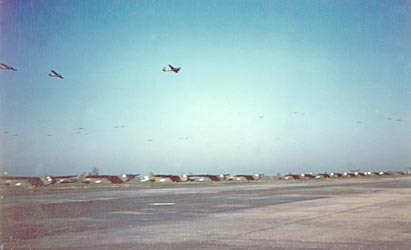
A58 Coulommiers, France
February - July 1945
Click here to return to the Ramsbury Airfield page

Above: At the outbreak of World War Two colour photography was very much in its infancy, and as a result colour images from this period are quite rare. However, by the time America entered the conflict Kodakchrome colour slides were becoming quite popular in the United States, and rolls of this new type of film were being brought over to Europe by American GIs. This picture was taken at Coulommiers by Peter Demos, a radio operator with the 86th TCS. (P. Demos via D. Bolce)
All living accommodation at Coulommiers consisted of pyramidal tents which were dispersed in woodland surrounding the airfield.
Below: Don Bolce outside his "luxurious" living quarters. (D. Bolce).
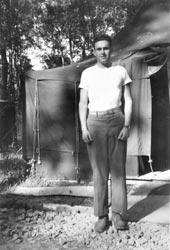
Below left: 437th personnel lining up for chow. (J. Antrim). Below right: 85th Squadron operations tents. (J. Antrim)
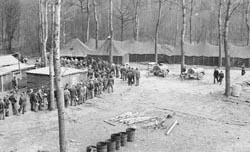
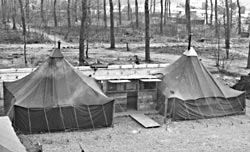
Operation 'Varsity
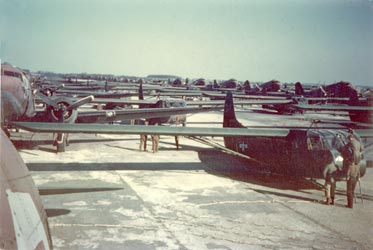
Above:
Just some of the seventy-two C-47 planes and 144 CG-4A gliders from the 437th
TGC that took part in 'Operation Varsity'.(P. Demos via D. Bolce)
By early March 1945, following months of bitter fighting, the British and American Armies had reached the western banks of the river Rhine. In order to cross the river a bridgehead needed to be established on the eastern bank from where the 21st Army Group, under the command of Field Marshal Montgomery, could thrust out into the north German plain. A crossing point was chosen between the German towns of Wesel and Emmerich and the assault began on the night of 23/24th March.
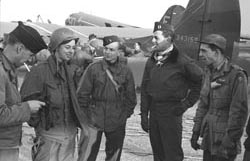 Since
August 1944 all British and American Airborne Divisions and Troop Carrier Groups
had been brought together under the collective umbrella of the 'First Allied
Airborne Army', commanded by Lt. Gen. Lewis Brereton. On the morning of 24th
March, after the main crossing had begun, the US 17th and British 6th Airborne
Divisions landed simultaneously on top of their objectives east of the river.
Since
August 1944 all British and American Airborne Divisions and Troop Carrier Groups
had been brought together under the collective umbrella of the 'First Allied
Airborne Army', commanded by Lt. Gen. Lewis Brereton. On the morning of 24th
March, after the main crossing had begun, the US 17th and British 6th Airborne
Divisions landed simultaneously on top of their objectives east of the river.
Unknown to the men of the
437th, planning for 'Varsity' started before they left Ramsbury for Coulommiers,
and they had about six weeks to settle into their new home before the operation
began. The group was tasked to carry glider troops from the 17th Airborne Division
in two serials to LZ 'S', just north of Wesel. Take-off time for the first serial
was scheduled for 07:30hrs and this was destined to become the very first double-tow
glider combat mission in airborne history! In addition to the airborne soldiers
the gliders also carried such things as; bazookas, rifles, machine guns, mortars,
howitzers, ammunition, Jeeps and trailers.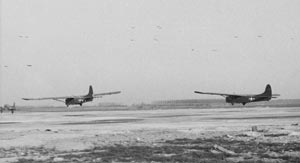
As the group neared its destination it received a warm reception from the enemy in the form of flak, machine gun and small arms fire and five aircraft from the group were destroyed with seven crew members lost. Second Lieutenant John Rauch, from the 85th TCS, was co-pilot of aircraft 42-100649 named 'Asphodel', which was brought down by German anti-aircraft fire. These are his memories of that terrible day's events…..
"Our crew consisted
of 1st Lt Richard Dean (pilot); 2nd Lt John Rauch (co-pilot); Tech Sgt Warren
Horr (crew chief) and S/Sgt. Charles Salerno (radio operator). The date and
time of the incident was March 24, 1945 at approximately 11:00 am. We were towing
two Waco CG4A gliders, one on a 700ft rope & the other on a 500ft rope.
The extra drag caused us to fly at about 90 to 105 indicated airspeed, just
a few hundred feet about the ground. The plane was hit in the right engine.
As soon as 1st Lt Dick Dean saw smoke and flames coming from the engine
he gave orders to jump. At about the same time he cut the gliders loose. Salerno
was gone in a wink of an eye followed by Horr and then myself. Dean was the
last one to leave the plane. The time period from being hit to total evacuation
was probably three or four minutes.
I was not all that high above the ground when I hit the silk and as I floated
down I recall seeing German soldiers running away from the area I was headed
so I hung limp in the chute, playing dead, just in case a German was looking
for a 'turkey shoot'. Dean and I landed about seventy-five yards apart. I went
through an apple tree and Dean got hung up in the branches of a larger tree.
We were both unhurt.
The apple tree was on a farm owned by a Mr. Wagner. As I approached the farmhouse
someone presented a white flag. One of the first questions the family asked
was, 'did I know a Hans Wagner from Missouri!' I said, 'No! I don't'. Obviously
they had no idea how big the United States' was! Soon the troops that had been
riding in the gliders that we'd released earlier showed up and, with little
conversation, locked the Wagners in a barn. This done, they helped us to a marshalling
area for 'shot down' airmen. Whilst with the troops we came across the remains
of 'Asphodel'. She had made a perfect landing but was burned out except for
the outer third of each wing and the tail section. Several days later, after
crossing the Rhine River, we arrived in Helmont before returning to Coulommiers,
France.
We decided to name our replacement aircraft Asphodel II. Our pilot Dick Dean,
chose the original name, which means "Lily of Hell".
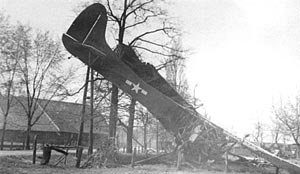
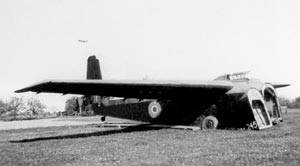
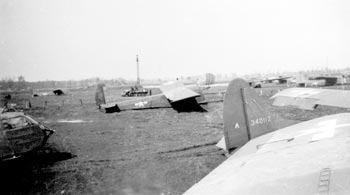
Above left: Nasty landing! Above centre: Some British equipment arrived in the huge Hamilcar glider. Above right: CG4A gliders on LZ 'S'.The glider in right foreground, tail number 340112, was flown by 1st Lt. John Schanck and 2nd Lt. Edward Ryan Jr. (All three pictures D. Ferriolo)
The following account is by Don Bolce (85th TCS) who flew as radio operator on aircraft 42-100806 during 'Varsity'…..
"When we arrived
in France in February 1945, I felt that there would be no more large airborne
combat missions ahead of us. I thought that our job was now to continue flying
needed supplies to the troops on the front line. If they needed gasoline, we
would load up our planes with 5 gallon jerry cans and land in a cow pasture,
if necessary, to make the deliveries. It didn't matter what was needed; ammunition,
food, medical supplies, we would deliver to any unit that needed our help. But,
suddenly rumours about a possible airborn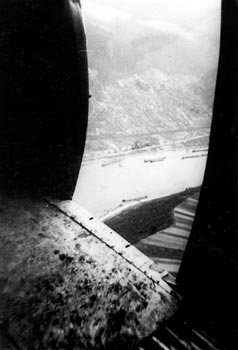 e
invasion across the Rhine River began to circulate.
e
invasion across the Rhine River began to circulate.
When we looked at the daily battle maps in the 'Stars and Stripes' newspaper
we could see that to cross the Rhine River an amphibious force would need airborne
support.
After flying all the previous missions without self-sealing fuel tanks, all
our 437th TCG aircraft finally receive them. The crew chiefs and their assistants
worked long and hard for many hours to remove the old wing tanks and install
the new self-sealing version. When "Monty", George Montgomery our
crew chief, removed the metal strap holding the old gasoline tank in the left
wing, a spent bullet that had penetrated our plane on D-Day was found. I have
always wondered what would have happened if that bullet had gone into the tank,
instead of just wedging between the tank and the steel strap.
With the installation of self-sealing fuel tanks in progress at an accelerated
pace it seemed likely that a combat mission was no longer a rumour but a reality
that we must face one more time. For whatever reason, I did not feel good about
the upcoming mission. I had a dull, sort of empty feeling in my stomach, which
would not go away. Call it butterflies, call it what you like, I guess that
I was just plain scared. We had been so lucky on D-Day, the airborne parachute
invasion of Southern France, the airborne invasion into Holland, the re-supply
of the 101st Airborne at Bastogne, but now, I felt that my luck was about to
run out.
After the briefing for Operation Varsity I went to church and prayed that I
would survive the mission but if I did not, that God would forgive me my sins,
and take me to heaven. At the service, I met a young 2nd lieutenant, a pilot,
who had just joined our outfit. He told me that he would be flying the mission
too, and that he was really frightened. He said that he had been checked out
to fly as a co-pilot on a C-47, but because there was a shortage of glider pilots,
he was going to be flying as a co-pilot on a CG-4A Glider. He said that he had
never been in a glider before, and that he had not had the infantry training
that the regular glider pilots had completed. This was his first mission. I
don't know whether he made it or not, but I truly hope he did!
On March 24, 1945, we
lined up all 72 of our C-47s on the runway at A-58, Coulommiers, France. We
had two CG-4A Waco Gliders attached to each C-47. The marshalling of so many
airplanes and gliders left us with a lot less runway length to get two gliders
off the ground at the same time, and to be able to get up sufficient speed to
get the C-47 into the air. There were a lot of tall trees at the end of the
runway, and I knew that we had to get both gliders, and the C-47 into the air
before reaching that point.
I watched from the astral dome as the first C-47 and its two gliders lumbered
down the runway at full throttle, 50 inches of mercury! When the combination
reached the end of the runway, both gliders were already in the air. Then, the
C-47 lifted off the runway at a speed just a little bit above stalling and barely
cleared the trees. The mission was underway.
When it was our turn to take off, we pulled forward until the towropes had no
more slack. Then, pilot Captain Floyd Kelly and co-pilot, Major Joe Antrim gave
us full throttle and the airplane began to move slowly, and gradually picked
up speed. Two fully loaded gliders, plus the gross weight of the airplane, was
a challenge for our two Pratt and Whitney engines to get us all into the air
before we reached the trees at the end of the runway. The two gliders were into
the air relatively soon as our C-47 struggled to pick up sufficient speed to
get airborne. As we neared the trees, Kelly pulled back on the controls and
we sort of "mushed" into the air. We gained altitude, and joined up
with our formation on its way to Germany.
It was to be a long mission. I don't remember how many hours it took to get
to Germany, but I remember that the turbulence from so many aircraft flying
together at the same time made our gliders bounce around violently, which caused
their tow ropes to constantly jerk the tail of our aircraft in all directions.
The C-47 pilots had their hands full, trying to keep the airplane straight and
level, but the glider pilots were having a life and death struggle to control
their gliders in the worst turbulence that any of them had previously experienced.
It seemed that we would never get to the Rhine River and the LZ.
Before we reached the River we began to notice a lot of smoke and I could tell
that the combatarea was not f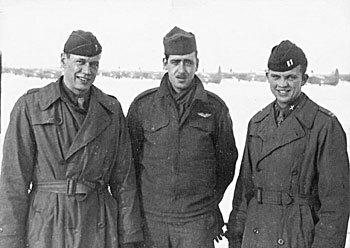 ar
away. I stood up in the astral dome and could see lots of action up ahead. We
were not encountering any ground fire, but I could see that we would soon be
crossing the Rhine with our two gliders bouncing around behind us. All of a
sudden it was like Normandy again. The ground fire was extremely intense, and
I thought to myself that this is worse than D-Day as this time it was daylight
and the Germans can see us! It was extremely smoky, and visibility was limited,
but we reached the LZ and our gliders cut loose. They were just as glad as we
were to be finally free and no longer a sitting duck at the end of a towrope.
ar
away. I stood up in the astral dome and could see lots of action up ahead. We
were not encountering any ground fire, but I could see that we would soon be
crossing the Rhine with our two gliders bouncing around behind us. All of a
sudden it was like Normandy again. The ground fire was extremely intense, and
I thought to myself that this is worse than D-Day as this time it was daylight
and the Germans can see us! It was extremely smoky, and visibility was limited,
but we reached the LZ and our gliders cut loose. They were just as glad as we
were to be finally free and no longer a sitting duck at the end of a towrope.
We made our turn, dropped our towropes in the assigned area, crossed the Rhine
River and headed for home - We had made it! I couldn't believe that the German
gunners were not able to shoot us down since we were flying so low, and so slow.
We were very lucky.
Upon our returned to Coulommiers, after a very long and dangerous flight, it
felt good to get something to eat and head for our tents. Many of our C-47 crews
had still not returned to base. Radio operator Chuck Salerno's cot was empty
in our tent that night. The following day we discovered that he had bailed out
over Germany, but it was several days before we heard that he had survived.
Radio Operator Jim Lyons had been shot down and was in a hospital with the rest
of his crew, all badly injured. My friend, Captain Victor Deer and his co-pilot
Lt. Eldred Trachta were shot down and killed. Crew Chief Gerry Cataline and
his crew crash-landed in a schoolyard in Bon Germany. Radio Operator George
Babich and his crew made an emergency landing with the fuel control valve shot
out. There were so many more, but I do not know all their names.
Above right: From left to right; Co-Pilot 2/Lt Eldred Trachta, Radio Operator S/Sgt Earl C. Nordgren, and Pilot Capt. Victor E. Deer pictured during early 1945. All three, together with Navigator 1/Lt Bryce C. Gibson, were to lose their lives during operation 'Varsity' when their aircraft C-47 43-15493 was brought down by enemy gunfire. The only survivor was Crew Chief T/Sgt. Paul B.Lefever who managed to bale out moments before the aircraft crashed. (via J. Paul Lefever)
The following personnel from the 437th TCG lost their lives during operation 'Varsity' :
C-47 Crews
Capt. Victor R. Deer; 2nd Lt Eldred Trachta; 1st Lt Bryce Gibson Jr.; S/Sgt.
Earl C. Nordgren;
Capt. Samuel
Fleming; 2nd Lt. Robert C. Regan; S/ Sgt. Joseph P. Reilly.
Glider Pilots
F/O Harvey D. Thacker; F/O Arthur R. Johnson; F/O Alexander S Warden; F/O Frank
W. Giannobule
2nd Lt. William T. Merriman; F/O Warren R. Miller; 2nd Lt. Francis J. Paul
Following operation Varsity the 437th continued with its resupply and evacuation work. Below left: Three 85th TCS aircraft flying low over the German countryside and (below right) a C-47 landing on a very soggy landing strip in Germany. Note the Jerry cans in the right-hand corner and three C-47s in formation at top left. As a result of the wet conditions one aircraft overshot and crashed at the end of the runway. (Both pictures D. Bolce)
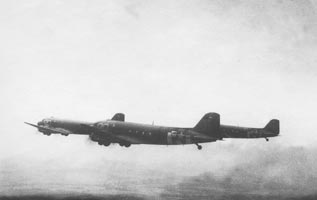
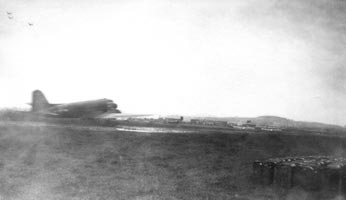
Below left: The remains of a German Gotha GO242B transport glider and below right a Junkers 88H/Fw190A 'Mistel S3B' at an unknown airfield (more details to follow). (J. Antrim)
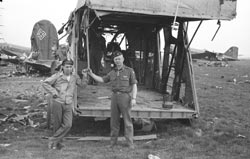
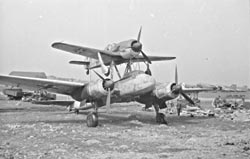
Below: A damaged C-47 from the 84th Squadron. (J. Antrim).
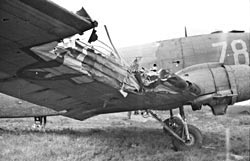
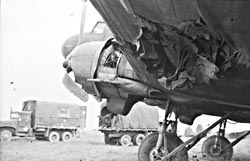
Below: Hooking up gliders in preparation for a double tow mission. (D. Bolce)
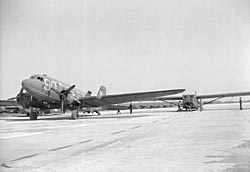
Below left: Radio operator Don Bolce at Coulommiers standing beside his C-47 42-100806. (D. Bolce). Below right: 'Wheels up'. (D. Bolce)
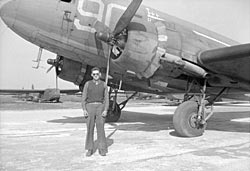
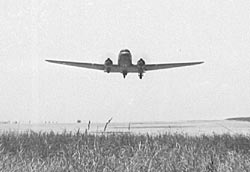
Below: A 'dog-eared' but very interesting picture of the signal square at Coulommiers. Following its capture by the Allies this former Luftwaffe airfield was given the designation A-58. All Allied airfields in Europe with an 'A' prefix were used by the Americans and those with a 'B' prefix by the British. (Picture via Gerald Theis)
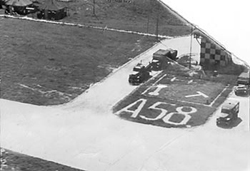
Below: A Spitfire XI (PL789) at Coulommiers. This aircraft served with 54 Photo Reconnaissance Squadron RAF from September 1944 and was struck off charge in 1947. Thanks to Mr Dan Johnson for identifying the squadron. (D. Bolce)

Below: A Mosquito PR VI or PR XVI of 540 Sqn. which operated out of Coulommiers from March 1945. They were carrying out non-military aerial survey work on behalf of the British Government, after which they returned to RAF Benson in Oxfordshire. Thanks to Mark Brock for this information. (D. Bolce)

Below: Don Bolce sightseeing in Paris at the Eiffel Tower (left) and the Arc de Triomphe. (D. Bolce).
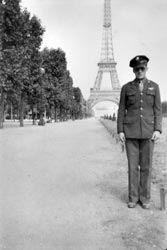
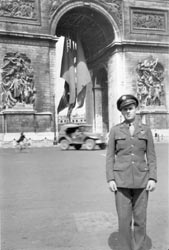
Click here to return to the Ramsbury Airfield page
©
Copyright 2007 Roger Day